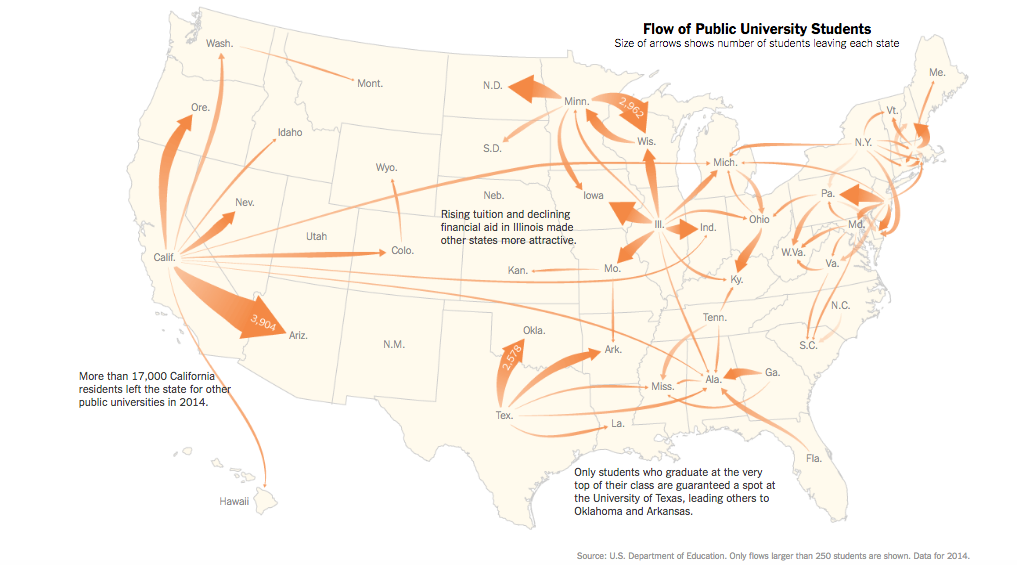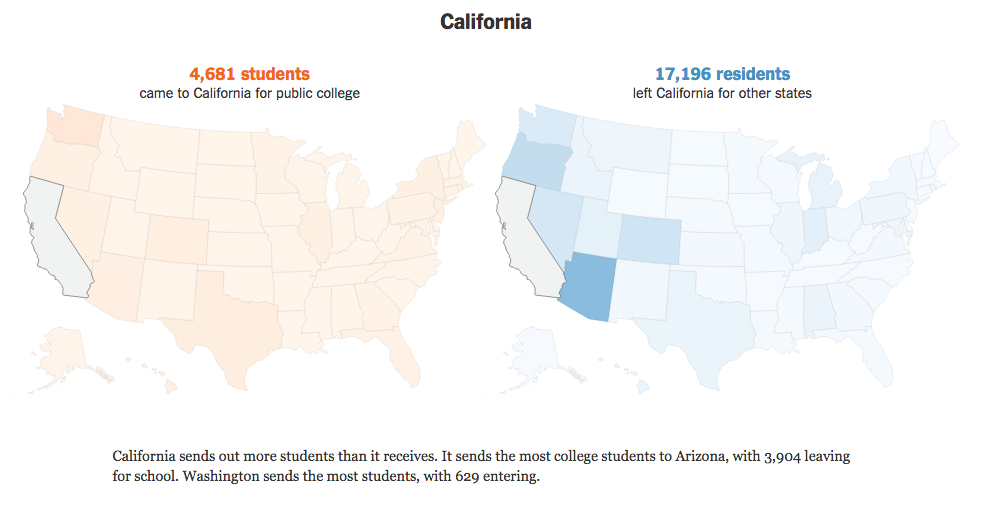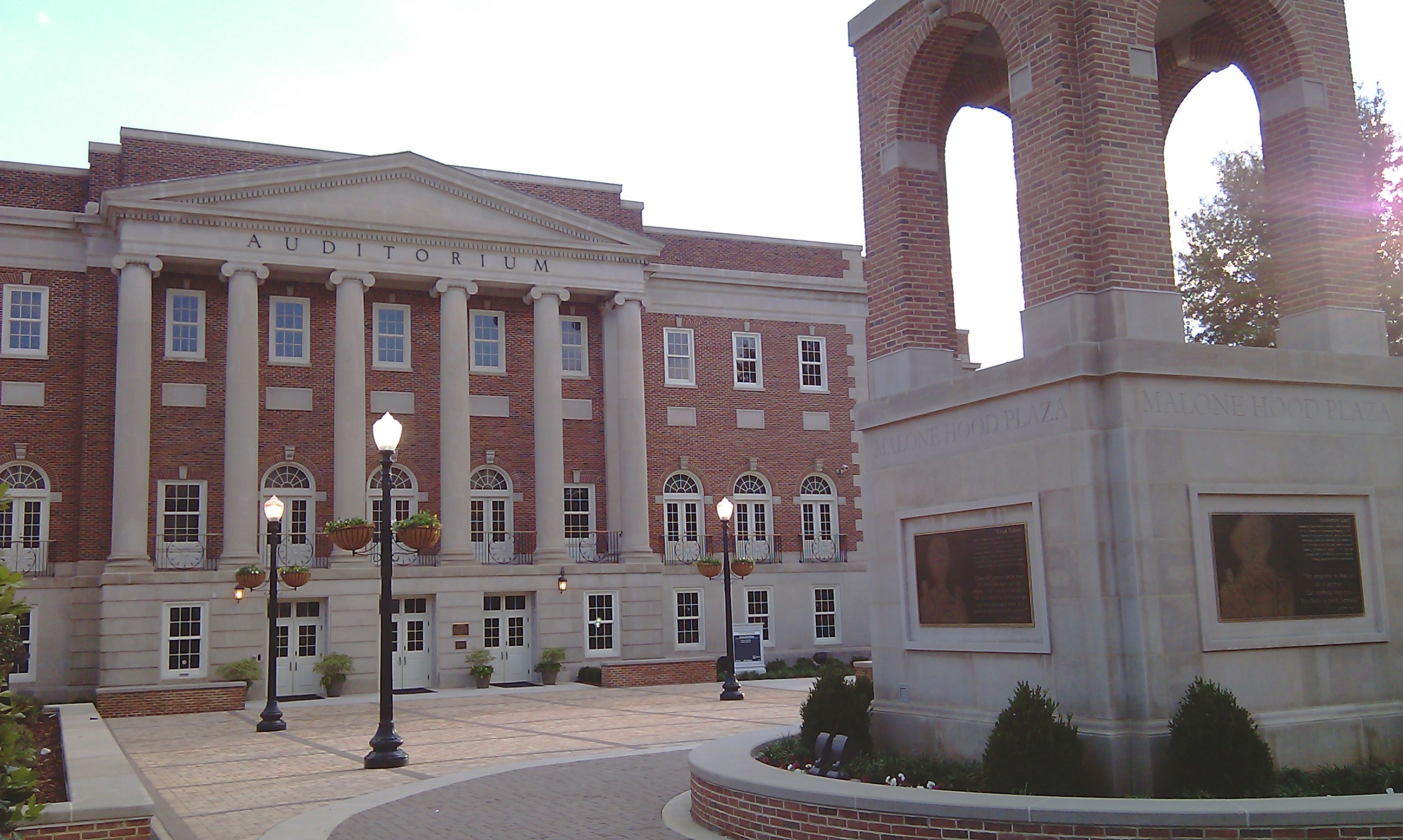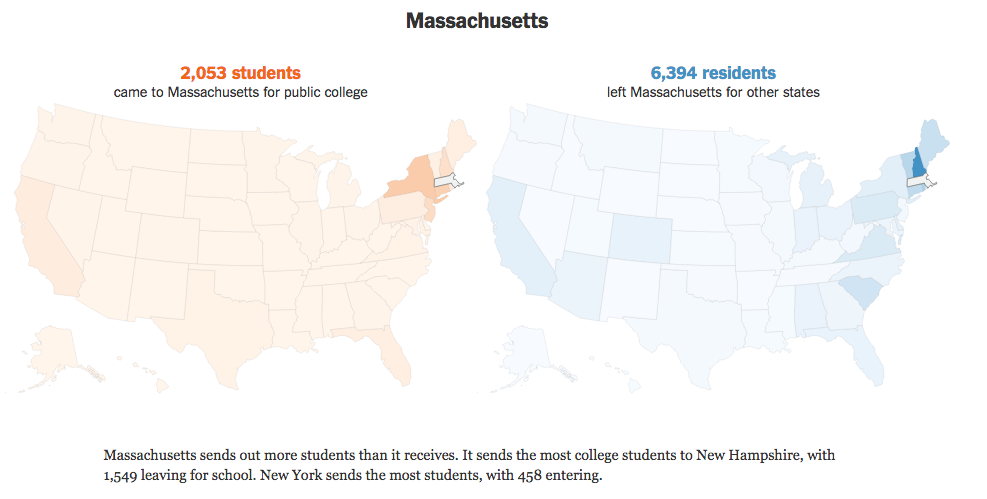These Maps Show How Rising College Costs Are Forcing a Huge Student Migration

By:
Tuition costs at public universities are rising, and that's leading them to recruit more students from out of state and from foreign countries — students who can afford to pay higher tuition — according to a New York Times story (behind a paywall).
At the same time, in-state students find themselves at a disadvantage for admission to their own state schools while also paying much higher in-state tuition than in previous years.
The imbalance has grown so noticeable that Democratic presidential nominee Hillary Clinton commented on it, the Times reported:
“We have got to get back to using public colleges and universities for what they were intended,” Mrs. Clinton said during a California campaign stop. “If it is in California, for the children in California. If it is in New York, for the children in New York.”
You can blame post-recession budget cuts in public funding to state universities.
The average cost of tuition with room and board at a four-year public university has almost doubled, rising to $19,548 in 2015 from $11,655 in 2000, adjusted for inflation, the Times reported.
The cost of attending public universities has risen 33 percent since 2008 as public spending on higher education has fallen 17 percent, according to a recent report by the nonpartisan Center on Budget and Policy Priorities.
As a result, the student body at many state universities comprises more out-of-state and foreign students.
A Times map illustrated how students are traveling across the country to attend college.
 The New York Times - nytimes.com
The New York Times - nytimes.com
Parents in states with top public universities argue that it's more difficult for their children to get into state schools and that out-of-state applicants are getting preferential treatment.
These concerns were confirmed by a University of California state audit in March. It found that the state "gave favorable admissions treatment to thousands of higher-paying out-of-state and foreign students, to the detriment of Californians," the Times reported.
Non-resident students make up 15.5 percent of UC system students overall. But that figure is much higher at more desirable UC campuses, such as UC Berkeley, where 29 percent of enrolled students come from outside of California.
Another Times map showed how this is playing out in California.
 The New York Times - nytimes.com
The New York Times - nytimes.com
UC President Janet Napolitano told the Times that budget cuts have forced universities like hers in nearly every state to make a "Hobson's choice, and they all have reached the same decision: Open doors to out-of-state students to keep the doors open for in-state students."
California isn't the only state where this is happening.
"Purdue and the Universities of Oregon, Iowa, and Michigan each enroll more than 40 percent out-of-state students, and Penn State, Iowa State, Indiana University, Georgia Tech, and the Universities of Wisconsin, Georgia, Virginia, and Arizona enroll more than 30 percent," the Times reported.
The University of Alabama in Tuscaloosa has seen the most dramatic shift in student residency, according to The Washington Post.
Seventy-two percent of incoming freshmen hailed from Alabama in 2004; in 2014, only 36 percent of freshmen were from within the state.
 Wikimedia Commons - wikimedia.org
Wikimedia Commons - wikimedia.org
Massachusetts is also wrestling with the issue.
Out-of-state enrollment at Massachusetts state universities has spiked almost 85 percent since 2008, according to a recent report by the Pioneer Institute.
Here's how it maps out:
 The New York Times - nytimes.com
The New York Times - nytimes.com
For its part, the University of Massachusetts Amherst defended its admissions policies, arguing that they didn't come at the expense of in-state-applicants.
The influx of out-of state students has disadvantaged low-income and minority applicants, according to a January study published in the Journal of Higher Education.
From the study:
"Though founded with a commitment to access, public research universities face pressure to increase tuition revenue and to recruit high-achieving students. These pressures create an incentive to recruit nonresident students, who tend to pay more tuition and score higher on admissions exams, but who also tend to be richer and are less likely be Black or Latino."
But that's not true at the University of Alabama in Tuscaloosa, where the student body has actually become slightly more racially diverse in recent years.
The undergraduate study body went from 83 percent white in 2004 to 77 percent in 2014, the Post reports. And the Tuscaloosa university last year elected a Black student government president, Elliot Spillers, for the first time ever.
"Students here from Chicago, Texas, California — they're changing the culture of this university," Spillers told the Post. "They have been able to put pressure on this campus and make a difference — and change it for the better."
